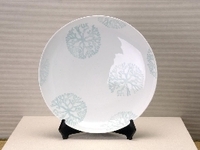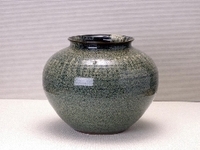

Total:131items
- Pottery & Porcelain (18)
- Koshu Kimen Gawara: Koshu Tile with a Devil’s Face
- Hasami Yaki: Hasami Porcelain
- Kiyomizu Yaki: Kyo style ceramics, Kiyomizu ware
- Otani Yaki: Otani Pottery
- Izushi Yaki: Izushi Porcelain
- Onta-yaki: Onta Pottery
- Takahama Yaki: Takahama Porcelain
- Mushiake- Yaki: Mushiake ware
- Kikuma-Gawara: Kikuma Roof-Tile
- Zeze-Yaki: Zeze ware
- TsutsumiYaki: Tsutsumi Pottery
- Hira Shimizu Yaki: Hira Shimizu Ware
- Tajima Banko Yaki: Tajima Banko Pottery
- Shidoro-Yaki: Shidoro Ware
- Amakusa Tojiki: Amakusa ware
- Shibukusa-yaki: Shibukusa ware
- Karatsu Yaki : Karatsu Ware
- Satsuma-yaki : Satsuma Ware
- Lacquerware (4)
- Glasswork (2)
- Wood & Bamboo Work (19)
- Leather Work (1)
- Papermaking (13)
- Textile (20)
- Dyeing products (5)
- Masonry (1)
- Metal Work (11)
- Stationery (4)
- Livingware (3)
- Accessory (4)
- Toys & Entertainment (14)
- Interior (2)
- Other crafts (10)

 |
Main Production Site:Kumamoto |
 《Characteristics》
《Characteristics》Aamakusa ware is a generic term of pottery and porcelain items which are baked in the Amakusa region of Kumamoto prefecture (Southern Japan).
The name of Amakusa ware was newly applied when the ware was nationally designated as a traditional craft product. Amakusa ware is mainly produced in four main regions, based on which they are named: Uchida-sarayama ware, Takahama ware, Mizuno-daira ware and Maruo ware, respectively. The porcelain is made by Amakusa porcelain stone of high purity and good quality.
The porcelain is characterized by its transparent pure whiteness and warm texture created using mokuhai glaze, or wood-ash glaze. As for pottery, lots of unique products are created using namako glaze, or indigo-violet devitrified glaze, which employs a double glazing technique, and also created by black glaze.
Uchida-sarayama ware
For Uchida-sarayama ware, using Amakusa porcelain stone as material, white porcelain dishes are mainly produced. The ware is painted with Araiso-kuzushi patterns (with figures of carp jumping high in rough waves, as carp are believed to be a lucky sign) and Unryu patterns (painting of a dragon and clouds) using the Gosu-sometsuke technique (blue and white ware with thick and grayish white base, characterized by bold pictorial designs).
Takahama ware
Takahama ware is porcelain made from high purity porcelain stone produced on the west coast of Amakusa. White porcelain dishes are mainly produced, marked by exceptionally transparent whiteness not seen in other ware.
Mizuno-daira ware
Originally Mizuno-daira ware used to be unglazed. Sometime later glaze was created and namako glaze, the main feature of Mizuno-daira ware, was born after further study. The namako glaze is created by baking ware with an iron underglaze and a straw-ash overglaze, which are blended in the process, producing unique pictorial patterns.
Maruo ware
Maruo ware uses red clay collected around the Marugaoka area and Amakusa porcelain stones. The products are simple and rough-hewn based on youhen draining glaze (a glaze which changes itself by the kiln blaze without craftsmen's interaction). Its main products are tableware.
[Traditional Craft Object designated by Minister of Economy, Trade and Industry]
Courtesy of: Amakusa Ware Development Association
Reviewed by Tomoko Yamamoto

| Materials | Amakusa porcelain stones, potter's clay and clay, etc. |
|---|---|
| Crafting Processes | Uchida-sarayama ware
Mined porcelain stones are finely ground. The ground porcelain stones, after being stirred with water, are elutriated (elutriation: materials with high specific gravity sinking to the bottom are taken out while those with low specific gravity are washed away) and the remaining ground stones with high specific gravity are kneaded to prepare clay. Shaping is done by hand wheel or kick wheel or by cast molding (forming with plaster mold). After being dried, the shaped clay is bisque-fired with partial dyeing on the unglazed pottery, then glazed and glost-fired. Takahama ware Materials are finely ground, stirred with water and elutriated. The elutriated materials are kneaded after being dehydrated to remove air. Shaping is done by wheel or plaster mold. After being naturally dried, the shaped clay is bisque-fired at a temperature of around 900 ℃, underglazed, glazed, and finally glost-fired. Mizuno-daira ware After original clay is mined, stirred with water, elutriated, and dehydrated, the clay is kneaded by kneading machine or by hand. The clay is shaped by wheel or plaster mold and, when half-dried (in pottery it is called a "leather-hard" condition), finished by planing. The planed clay is bisque-fired at a temperature of 700℃-800℃, glazed and glost-fired at a high temperature. Maruo ware Materials are finely ground, stirred with water and elutriated. Dehydration and kneading is done followed by kick-wheel shaping. When half-dried, the clay body is finished by putting designs on them with bamboo spatula. After being sufficiently dried, the finished clay is bisque-fired, glazed and glost-fired. |
| History | Since Amakusa was under the direct control of the Shogunate (the Tokugawa shogunate, the last feudal Japanese government which existed in the Edo period between 1603 and 1867), there was no goyo-gama (domain-kilns). Instead, each village headman promoted local economy development by selling porcelain stones or baking wares.
In the Genroku era (1688-1700), Amakusa porcelain stones were sold as grindstone. Since around 1712, the stone was provided to Saga and Nagasaki areas (Southern Japan) as porcelain materials and eventually spread throughout the country. On Amakusa Island, ancient documents show that porcelain was baked in Uchida-sarayama in 1676. There are also records showing that the porcelain production started in Takahama village in 1762 when Takahama village headman Ueda brought in potters from Hizen (present day Saga or Nagasaki Prefecture, Southern Japan) and had them start baking porcelain. Meanwhile, in 1765, pottery ware started to be baked by headman Okabe in Hondo village, in the Mizunodaira area. Furthermore, in the later period of Edo (1804-1830), another headman Kanazawa started pottery kilns. Some areas have continuously baked Amakusa wares for over 200 years, and many of the wares are full of richness and uniqueness, and demonstrate both long-cherished tradition and young modern sensitivity. |
◆Exhibition / Showcase
For more information:
Amakusa Ware Development Association
Kiyama Touseki Kougyousho, 554-1, Uchida, Reihoku Town, Amakusa County, Kumamoto Prefecture 863-2505, Japan
Tel: +81-(0)969-35-0222/Fax: +81-(0)969-35-0358 (Japanese only)
Assistance needed? For inquiries in English:
JTCO Contact Form
Your inquiries will be forwarded by JTCO in Japanese to the organization you wish to contact.
*Please write the name of craft you wish to ask about.



